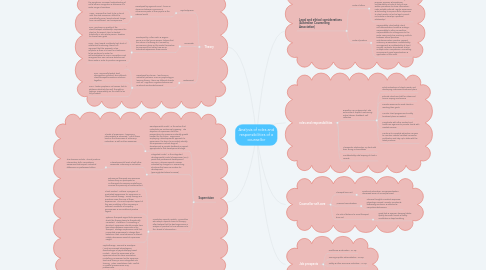
1. Theory
1.1. Psychodynamic
1.1.1. Developed by sigmund Freud - focus on dynamics between conscious & unconscious parts of then psyche & the external world
1.1.1.1. Pros - looks at the inner problem, not just the symptoms, Increased understanding of self & others, recognition & tolerance of a wider range of emotions
1.1.1.2. Cons - requires the client to be in touch with their sub-conscious, difficult to scientifically prove, less structured, longer term committment, can be expensive
1.2. Humanistic
1.2.1. Developed by Adler, Rank, & Rogers - Focus is on the human person, believe that the notion of suffering isn't caused by unconscious drives or life events themselves (environment) but rather how we as individuals experience these events
1.2.1.1. Pros - emphasis on quality of the client/therapist relationship, empowers the client as the expert, client is treated holistically or as a whole person, freedom to choose own goals
1.2.1.2. Cons - client needs a relatively high level of intellectual functioning, there is an argument that the approach is too simplistic & there is a need for a behaviour to be reinforced in order for self-actualisation to occur, counsellors must recognise their own values & beliefs & set them aside in order to practice congruence
1.3. Behavioural
1.3.1. Developed by Skinner - less focus on individual pioneers, more on psychology & learning theory - there are different strands such as - cognitive, cognitive-behavioural, & rational emotive-behavioural
1.3.1.1. -
1.3.1.2. Pros - empirically tested, brief interventions, practical, time efficient, client/therapist brainstorm solutions together
1.3.1.3. Cons - treats symptoms, not causes, fails to address individuals free will, thoughts & feelings, responsibility on the client to be fully invested
2. roles and responsibilities
2.1. Empathy, non-judgemental, safe environment, respect, welcoming, active-listener, feedback, self reflection
2.1.1. initial evaluations of clients needs, and developing customized treatment plans
2.1.2. Educate clients and staff on stress and trauma coping mechanisms
2.1.3. Provide resources to assist clients in reaching their goals
2.1.4. Monitor client progress and modify treatment plans as needed
2.1.5. Coordinate with other medical and healthcare agencies to provide clients with needed services
2.1.6. Continue to complete education courses to maintain national certified counsellor certification and stay up to date with the latest practices
2.2. Therapeutic relationship, up front with fees, timing, & boundaries
2.3. Confidentiality, safe keeping of client's records
3. Counsellor self-care
3.1. Therapist burn-out
3.1.1. emotional exhaustion, De-personalization, decreased sense of accomplishment
3.2. Vicarious traumatisation
3.2.1. Intrusive thoughts, avoidant responses, physiologic arousal, somatic complaints, distressing emotions, & addictive & compulsive behaviours
3.3. The role of balance to avoid therapist burn-out
3.3.1. good diet & exercise, sleeping habits, quality time with friends & family, meditation & deep breathing
4. Supervision
4.1. Developmental model - is the notion that individuals are continuously growing. The objective of supervision from this perspective is to maximise & identify growth needed for the future. Supervisors employing a developmental approach to supervision, the key is to accurately identify the supervisee's current stage of development & provide feedback & support appropriate to that developmental stage.
4.1.1. 3 levels of supervision - beginning, intermediate, & advanced. Within these levels is the three areas of autonomy, motivation, & self & other awareness.
4.2. Integrated model - is the integrated developmental model of supervision (IDM) posits that professional development occurs in a domain-specific manner, indicated by changes in 3 overarching structures that serve as markers for development. (apa.org/pubs/videos/4310948)
4.2.1. 3 developmental levels of self-other awareness, autonomy & motivation
4.2.1.1. The domains include: clinical practice, intervention skills, competence, assessment techniques, individual differences, & professional ethics.
4.3. Orientation specific models - counsellors who adopt a specific brand of therapy - often believe that the best supervision is analysis of practice for true adherence to the "brand of intervention".
4.3.1. Behavioural therapists as supervisors believe they can participate as co-therapists to maximise modelling & increase the proximity of reinforcement.
4.3.2. Client-centred - outlines a program of graduated experiences for supervision in client-centred therapy. Group therapy & a practicum were the core of these experiences. The most important aspect of this was modelling of the necessary & sufficient conditions of empathy, genuineness, & unconditional positive regard.
4.3.3. Systemic therapists argue that supervision should be therapy-based & theoretically consistent. Therefore, if counselling is structural, supervision should provide clear boundaries between supervisor & the therapist. Strategic supervisors could first manipulate supervisees to change their behaviour, then once behaviour is altered, initiate discussions aimed at supervisee insight.
4.3.4. Psychotherapy - Bernard & Goodyear (1992) summarized advantages & disadvantages of psychotherapy based models. When the supervisee & the supervisor share the same orientation, modelling is maximised as the supervisor teaches & theory is more integrated into training. When orientations clash, conflict or parallel process issues may predominate. cyc.net.org/eye-online/cycal-0101-supervision
5. Job prospects
5.1. Healthcare & education - 47.4%
5.2. Training & public administration - 40.2%
5.3. Safety & other services & industries - 12.4%
5.4. Counsellors | JobOutlook
6. Legal and ethical considerations (Australian Counselling Association)
6.1. Code of ethics
6.1.1. non-judgemental, free of discrimination, helping relationship, empower client, ongoing committment to professional development, client understanding of purpose, process, & boundaries, confidentiality & limits of duty of care, written permission to share information, make suitable referrals, regular supervision & de-briefing to improve skills, responsive to client needs, not act as legal counsel, not initiate or develop a personal relationship/
6.2. Code of practice
6.2.1. responsibility, client safety, client self-determination, breaks & endings, responsibility to other counsellors, responsibilities to colleagues & to the wider community law, resolving conflicts between ethical priorities, anti-discrimination practice, respect, autonomy & awareness, confidentiality, management & confidentiality of client records, contracts, boundaries, dual & multiple roles, competence, counselling environment, equal opportunities, & application of the code.

